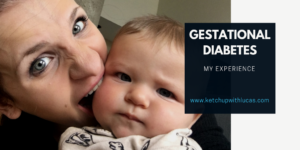 When I was about 24 months pregnant with Lucas, I took, like most women, a test for gestational diabetes. And I failed it. I had to come back for a second three-hour long test. The nurse taking my blood took a look at me, and said, “there is no way you have gestational diabetes.” But she was wrong, I did. She took my blood over the course of 3 hours, to the point where my body refused to give her blood during the third test. But no matter, I had failed so spectacularly that they didn’t need that third data point. I learned later that half of the women who have gestational diabetes don’t have any risk factors.
When I was about 24 months pregnant with Lucas, I took, like most women, a test for gestational diabetes. And I failed it. I had to come back for a second three-hour long test. The nurse taking my blood took a look at me, and said, “there is no way you have gestational diabetes.” But she was wrong, I did. She took my blood over the course of 3 hours, to the point where my body refused to give her blood during the third test. But no matter, I had failed so spectacularly that they didn’t need that third data point. I learned later that half of the women who have gestational diabetes don’t have any risk factors.
My doctors told me that if I didn’t change my diet, I could hurt the baby – he could come out very large (complicating his birth), or could have complications after birth. The first order of business was to try to control my blood sugar through diet. The doctors told me that if this didn’t work, I would need to go on insulin.
 The way that you test blood sugar is through a glucose monitor device. You prick your finger, a small drop of blood comes out, which you place onto a test strip. Then the monitor tells you how much sugar is in your blood. I pricked my fingers four times a day (pre-breakfast, and after each meal). Sometimes the first prick didn’t work, and enough blood didn’t come out. Sometimes I got really unlucky and the first four pricks didn’t work. My first real “finger pricking” (outside of a doctor’s office) was after my breakfast. I thought I was doing fine – I had a small bowl of plain cheerios with some milk. But, when I tested my blood sugar, my blood sugar was out of control. It was then I realized that I had to make some drastic changes to my diet if I wanted to control without insulin. At this point, I did a drastic change to my diet – I refused to touch sugar except in very small quantities, I cut out all white flour from my diet, and I loaded up on protein and veggies. And, all this time, all I wanted was a nice baguette. But I kept thinking about the baby, and how I could hurt him by letting my blood sugar get out of control.
The way that you test blood sugar is through a glucose monitor device. You prick your finger, a small drop of blood comes out, which you place onto a test strip. Then the monitor tells you how much sugar is in your blood. I pricked my fingers four times a day (pre-breakfast, and after each meal). Sometimes the first prick didn’t work, and enough blood didn’t come out. Sometimes I got really unlucky and the first four pricks didn’t work. My first real “finger pricking” (outside of a doctor’s office) was after my breakfast. I thought I was doing fine – I had a small bowl of plain cheerios with some milk. But, when I tested my blood sugar, my blood sugar was out of control. It was then I realized that I had to make some drastic changes to my diet if I wanted to control without insulin. At this point, I did a drastic change to my diet – I refused to touch sugar except in very small quantities, I cut out all white flour from my diet, and I loaded up on protein and veggies. And, all this time, all I wanted was a nice baguette. But I kept thinking about the baby, and how I could hurt him by letting my blood sugar get out of control.
Throughout this process, the support staff that I had was fantastic. My OB (who was actually a really fantastic nurse practitioner) and an endocrinologist both checked up on me to make sure that I was doing all I needed to do. During my appointments with the endocrinologist, she wouls check the my historical blood glucose numbers by downloading the data from the glucose monitor. My endocrinologist said to me: “Olga, your numbers are spot on each day. How did you trick the monitor?” But I did, I just basically ate the same meal each day. I was really afraid. Side note – I will do another post about what I did to my diet to keep the blood glucose levels day over day.
Once I gave birth to Lucas, everything returned back to normal. I asked an hour after giving birth if I should check my blood, and they said no. But I had gotten so used to it that I did – and, right after a scoop of ice cream, my blood sugar was fantastic – almost as good as if I had had no carbs at all. But the warnings from my doctorsrang in myears: gestational diabetes is a warning sign. Those who have gestational diabetes are more likely to develop type 2 diabetes later on in life. I thought about the three months of living with diabetes, and realized that I needed to make the diet changes permanently. And I wanted to make them for my whole family.
So for Lucas, who is now on solid food, I try to cook with whole wheat flour, and no sugar, whenever possible. It’s not that I don’t let him have white flour or cake, I just try not to make a habit of it. His daycare has pizza Fridays, and Lucas loves them. Ultimately, I don’t wan t my son to have to worry about pricking his finger someday, and I want to set him up with healthy eating habits now to minimize the risk of that in the future. So that’s a lot of what you will find on this blog – my attempt at cooking in a healthier way.

